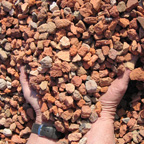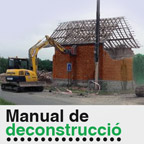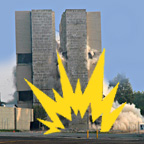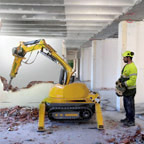
RECONSTRUCT project: new solutions to trim down the emissions of the construction sector
The objective of RECONSTRUCT is to develop circular, eco-friendly, and innovative solutions to reduce emissions from construction. Three different strategies for using less primary non-renewable materials will be tested: 1) sourcing local alternatives to conventional steel and cement; 2) using building components that not only incorporate recycled materials but are also designed for disassembly and reuse, and 3) integrating the deconstruction process into the very core of building design.

Incorporation of asbestos removal tasks into ITeC’s database
ITeC's database of construction elements has been expanded with the products, machinery and operations needed for asbestos removal as per the current regulations. In addition to the dismantling of boards, tanks and ducts, it also includes inspections and sampling, negative pressure equipment, individual and collective protections, and waste encapsulation and disposal. Each of them has its price and technical specs, so prescribers can use them in the project as easily as the rest of the products of the database.

We Build Circular project: opportunities to increase circularity
Construction waste in a building or in an infrastructure can become a resource if the appropriate decisions have been made in the design stage. Taking the waste inventory calculated by ITeC’s TCQiGMA software as a starting point, it is possible to know how much circularity is being missed, comparing the waste management scenario as prescribed by the project team and the optimal scenario according to the Waste Agency of Catalonia.

Quantifying the potential of disassembly of a building
Measuring the future disassembly potential of buildings during the project phase allows designers to take decisions from a circular economy perspective. ITeC has developed a calculation system that, based on the construction elements of the BEDEC database that have been selected for the project, identifies the way in which they will be joined together on site and provides ‘capacity of disassembly ratio’ expressed as a percentage value.

Implementation guide of the Decree 201/1994 regulating demolition and construction waste
Helps to define and clarify the concepts in the Decree, to submit evidence that proves compliance and to make clear the responsibilities of the different players involved in waste management. It assists in the drafting of the waste management project that has to be submitted when applying for planning permission for new projects of demolition, excavation and building.

Proposal to amend the building code introducing the reuse of demolition materials
One of the barriers that prevents the reuse of demolition materials is the building code itself since it does not contain any explicit provision regarding the use of waste. After seeking advice among prominent members of the drafting committees of the EH and PG-3 building codes, ??a proposal to make appropriate modifications has been drafted.

Deconstruction manual
Didactic handbook about deconstruction methods and techniques that emphasize the minimization of demolition waste. With graphical illustrations on how to address issues such as disassembly, separate collection and recycling of materials, in order to contemplate them in the design phase.

Case study for the application of deconstruction criteria when implosion is used for demolition
Proof of the technical and economic feasibility of deconstruction in a real case of demolition of an apartment block using implosion in the area of La Pau in Barcelona. It was possible to make a rational waste management as per the criteria of Decree 201/1994.

State of the art of demolition techniques
State of the art of the techniques for demolition of buildings, identifying the optimal combinations between construction and deconstruction systems, and the areas of compatibility with the process of selective salvage of materials. Includes experiences from other countries that show the feasibility of recycling and reusing in the current technical and economic context.



